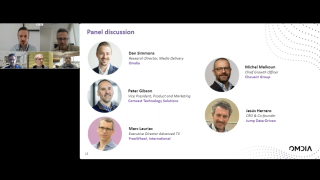Planning for the Future of Media Delivery
May 22, 2017
Can a content provider or programmer really “future-proof” its delivery model? It’s a pretty vague question, but asking the question internally isn’t so much about polishing your crystal ball, but about defining your priorities as an organization. Predictions about new platforms, new methods, or new technologies are important when it comes to charting a course, but every “next big thing” creates a lot of disruption to all the other big things connected to it. The rise of OTT services, for example, didn’t exactly take the world by surprise; but no one could have predicted the true scope of impact to business models, workflows, and consumer behaviors.
So, in the face of clear and present change, how are companies limbering up for the adventures ahead? For the most part it’s a matter of figuring out a way to manage existing components (both physical and procedural), and to integrate improvements seamlessly. Things like:
- Eliminating proprietary elements of the workflow that cannot evolve
- Executing business models with baked-in flexibility
- Leveraging the strengths of both digital and broadcast delivery methods
Swapping “Proprietary” for “Modularity”
An effective, elastic content delivery ecosystem is one that’s positioned to adapt to every permutation of change. A tectonic shift in the media landscape doesn’t occur in a vacuum, of course; but today’s content providers need a) the foresight to see how these three areas of change are coalescing to shape the future, and b) the operational agility to capitalize on them. Proprietary systems or processes can hamstring the adoption of new innovations by adding complexity and cost to future business requirements. A preferable strategy may be one that takes a more modular and standards-based approach that allows each content provider to construct their own tailored, best-in-class content management, distribution, and monetization platform. A good example would be your choice of an Origin solution which is not wedded to a specific CDN for delivery and that supports the myriad of formats, DRM, and dynamic ad-insertion methods. Bottom line, if there are advantages to replacing a specific “brick” in your overall capability stack – a custom UI from a boutique vendor, for instance or a specific ad decisioning engine – then you should be able to do it easily with little-to-no up or downstream implications.
The Elastic Business Model
At the same time that non-traditional delivery models have transformed the business landscape, technological advancements continue to drive changes to consumer behaviors. The optimal business model for a specific content library or experience is often elusive and it’s vital to have the agility to experiment with different monetization strategies. As I shared in this February blog, many content providers are creating big gains by taking a more innovative tack towards their revenue modeling. For example, many providers often launch with a one-price subscription model, but find that customers respond positively to a segmented offering with different tiers of access. Another possibility would be to fuse subscription and ad-based monetization to create a more personalized experience that realizes more lifetime value from both audience and content asset.
Digital and Broadcast: The Coming Singularity
In a January blog, I wrote about the unification of IP/OTT and traditional broadcast workflows has really taken off. Linear and digital content providers are delivering huge benefits to each other (and to viewers) by combining and harnessing all the strengths of traditional broadcast and OTT experiences. As this convergence culminates in a single platform, content providers will benefit not only from leaner operational cost but also consistent broadcast performance and the ability to create highly targeted and personalized experiences across every screen.
Virtual Reality (VR): The Next Real-Life Case Study
VR and AR (augmented reality) are going to usher in a new phase of incredibly immersive experiences. According to Cisco Systems’ Mobile Visual Networking Index for 2017, not only will video make up over 75% of all video traffic by 2021 (up from 60% last year), but they are predicting a five-fold increase in virtual reality headsets in the same time period. Furthermore, they forecast that only about half of those devices (51%) will be connected to mobile devices, which is a drop from 87% just last year. It’s a pretty good example of how user behavior changes when new platforms succeed with early adopters, and begin to take on a deeper role as a content pipeline.
This new platform will change the way we think about the impacts to delivery, monetization, and even how the value of content and consumer are measured. Will your content workflow, delivery and playout engines support the VR spec? What about your advertisers – will they be ready? Imagine a sports fan who can attend the Super Bowl in virtual reality, from anywhere on the planet. How would that event be valued, or captured to be re-experienced (and monetized)? What would ad placement look like with either a live or time-shifted viewing event? The answers are coming, and media brands with a forward-thinking content delivery strategy will be poised to capitalize on the next massive opportunity.
It’s an exciting time on both sides of the media delivery spectrum. On one hand, new technologies and viewing experiences are coming so fast that it’s hard to wrap a plan around them. On the other hand, meeting audience demand for differentiated content must remain at the core of your business model. As we all work to incorporate more quality and efficiency into our future workflows, anything that can keep more focus on what we’re delivering, and less energy on how, is worth investigating.




